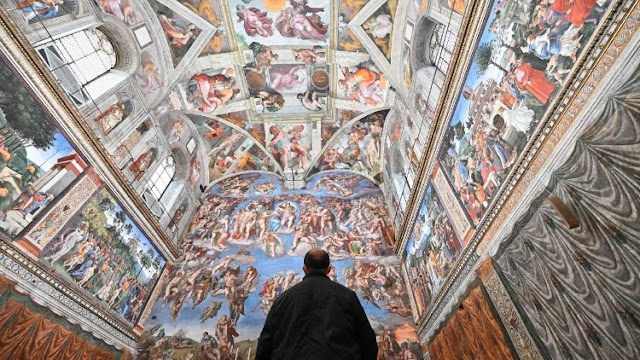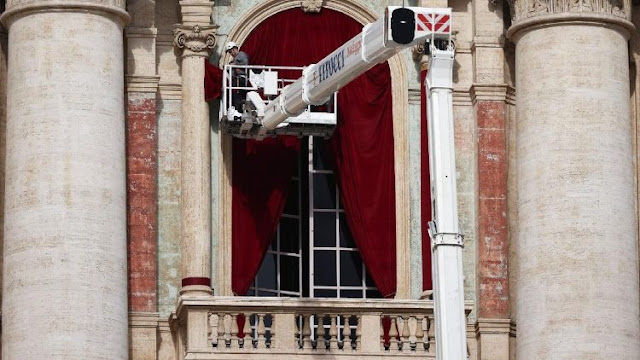The Sistine Chapel preparing for the 2025
Conclave (AFP or licensors)
The Conclave from the Middle
Ages to the present day
The Conclave as we know it today goes back to the Middle
Ages, and was established to prevent a prolonged Vacant See (Sede Vacante) and
outside interference.
By Lisa Zengarini*
The term “Conclave” comes from two Latin words: cum (with)
and clavis (key). In Church terminology, it designates both
the secluded place where the papal election is held, and the body of Cardinals
convened there to elect the new Pope.
Formally established
in 1274 by Pope Gregory X
The upcoming Conclave starting on May 7 to elect
the 267th Pope will be the 76th in the form we know today, which was
established by Pope Gregory X in 1274, and the 26th held under the gaze of
Michelangelo's Last Judgment in the Sistine Chapel.
Over the centuries, various reforms gradually shaped the
procedure for the election of the Pope. The first significant changes were
introduced by Pope Nicholas II in 1059 with the Bull In nomine Domini,
which specified that only cardinals could elect the Roman Pontiff.
Before that, the Successor of Peter was chosen with the
participation of the ecclesial community: clergy assessed candidates proposed
by the faithful, and the bishops chose the Pope. External influences and
interferences from political powers, of course, played a major role in the
election, often hindering the electoral process.
In 1179 Pope Alexander III promulgated the
Constitution Licet de vitanda introducing the requirement of a
two-thirds majority — a key element that remains today.
Preparations of the
loggia ahead of the Conclave
The 1268-1271
election in Viterbo, the longest in Church history
Then came the institution of the Conclave. This setting was
formalized in 1274 by Pope Gregory X in the Constitution Ubi periculum which
established that in future elections, cardinals should be locked away in
seclusion "cum clave," from both inside and outside, so they could
focus on their task of electing the next head of the Catholic Church “without
any political or personal interference.”
This followed his own election in the city of Viterbo in
1271 which lasted nearly three years (1268-1271), due to external interference,
and is known to be the longest in history. The story has it that 1268, 18
cardinals gathered in the papal palace of Viterbo to elect the new Pope but
couln't decide. Out of frustration the people of Viterbo decided to
locked them in the palace, and walled up the doors. Eventually, Teobaldo
Visconti, then Archdeacon of Liege, who was not a cardinal, nor even a priest,
was elected as Pope Gregory X.
The first Conclave in
in 1276
Following Ubi periculum, the first official
Conclave was held in Arezzo, Tuscany, in 1276 with the election of
Innocent V. In 1621, Pope Gregory XV introduced the requirement for secret and
written ballots. In 1904, Pius X abolished any claimed right of exclusion and
enforced secrecy about all that happens in the Conclave—even after iits
conclusion.
Changes from the 20th
century to today
After World War II, in 1945, Pope Pius XII issued the
Apostolic Constitution Vacantis Apostolicae Sedis, introducing new
rules. From the moment the Holy See is vacant, all cardinals—including the
Secretary of State and Congregation Prefects—cease their duties, except for the
Camerlengo, the Penitentiary, and the Vicar of Rome. Later, in the Motu
proprio Ingravescentem Aetatem, Pope St. Paul VI decreed that only
Cardinals under 80 years old could vote.
Not all Conclaves
have been held in the Sistine Chapel
The first Conclave to be held at the Sistine Chapel was in
1492. Although every Conclave has been held at the Sistine Chapel since 1878,
over the centuries elections had taken place in various locations before a
fixed setting was decided upon. Most were still held within Rome, but 15 have
previously taken place outside the Eternal City.
Some Conclaves have even been conducted outside of Italy.
The Conclave of 1314-16 was held in France, and a century later, the Conclave
of 1415-17 was held in Germany.
In his Apostolic Constitution "Universi Dominici
Gregis" , Pope St. John Paul II’s confirmed the most famous chapel in the
world, called the “Via Pulchritudinis” (Way of Beauty) as the official location
for the election of the new Pope.
The duration of
Conclaves
The duration of Conclaves varies. As mentioned above, the
longest election in history was that of Gregory the X, which took two
years and two months. On the opposite end of the spectrum is the one in 1503
which lasted only a few hours and led to the election of Pope Julius II.
The duration of the Conclave for late Pope Francis was
relatively short: he was elected on March 13, 2013 after just five rounds in
under two days.
Normally the newly elected Pope appears on the balcony to
greet the crowd in St. Peter’s Square within an hour from the smoke billowing
from the chimney over the Sistine Chapel.
Whilst every Pope over the last few centuries has been a
cardinal, this is not a requirement. This is extremely common however, and the
last Pope to be appointed that was not previously a cardinal was Urban VI in
1378.
*Amedeo Lomonaco contributed to this article.
https://www.vaticannews.va/en/pope/news/2025-05/the-conclave-from-the-middle-ages-to-our-days.html


Không có nhận xét nào:
Đăng nhận xét